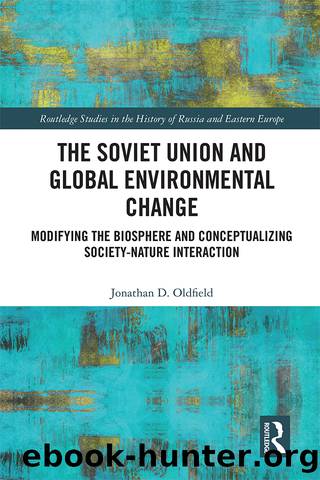The Soviet Union and Global Environmental Change by Jonathan D. Oldfield

Author:Jonathan D. Oldfield [Oldfield, Jonathan D.]
Language: eng
Format: epub
ISBN: 9781000393330
Goodreads: 56356597
Publisher: Routledge
Published: 2021-05-27T00:00:00+00:00
âGetting to knowâ the natural environment
The activities of the Russian Academy of Sciences during the late tsarist period with respect to evaluating Russia's vast natural resource base were in part the continuat ion of a long-standing interest of the Russian state to promote the exploration of the empire (Moon, 2010; Oldfield and Shaw, 2016, pp. 19-47). The vast size of the country in addition to its varied natural environments had long energized Russia's scientific community. This resulted in the production of detailed accounts of the country's natural characteristics linked to epic expeditions to the northern, eastern, and southern reaches of the empire from the mid-eighteenth centuty onward. In time, such activity encouraged the development of pioneering insights into the functioning of natural processes at different scales of analysis. The works of synthesis by individuals such as Mikhail Vasil'evich Lornonosov (1711-1765), geographer Lev Semenovich Berg (1876-1950), as well the aforementioned pedologist Dokuchaev and climatologist Voeikov are indicative of such activities. In spite of the extensive efforts of Russian scientists to familiarize themselves with the natural environment of the empire, the sheer scale of the task ensured that success was relative. The need for greater knowledge and understanding of even basic natural resource endowment was emphasized with the outbreak of World War I (WWI). Russian exposure to the German economy necessitated a strategic re-emphasis on domestic resource use, and yet the requisite knowledge was found wanting. This encouraged a coordinated response by Russia's scientific community in the form of a new initiative, the aforementioned KEPS. KEPS was significant for a number of reasons. First, it provided a structured framework for assessing and interpreting the potential extent of natural resource reserves; a structure which persisted in part for much of the twentieth century. Second, it signalled a shift within the scientific community in terms how natural resources were conceptualized, with a greater emphasis placed on their productive potential than had hitherto been evident. Third, the advancement of a purposeful and more systematic approach toward assessing the country's natural resource base provided a platform for later environmental monitoring activities and simultaneously encouraged a deeper appreciation of the complexities of the physical processes at work across the extent of the Soviet empire.
Download
This site does not store any files on its server. We only index and link to content provided by other sites. Please contact the content providers to delete copyright contents if any and email us, we'll remove relevant links or contents immediately.
Cecilia; Or, Memoirs of an Heiress — Volume 1 by Fanny Burney(32434)
Cecilia; Or, Memoirs of an Heiress — Volume 2 by Fanny Burney(31868)
Cecilia; Or, Memoirs of an Heiress — Volume 3 by Fanny Burney(31852)
The Great Music City by Andrea Baker(31327)
We're Going to Need More Wine by Gabrielle Union(18967)
All the Missing Girls by Megan Miranda(15561)
Pimp by Iceberg Slim(14378)
Bombshells: Glamour Girls of a Lifetime by Sullivan Steve(13972)
Talking to Strangers by Malcolm Gladwell(13222)
Norse Mythology by Gaiman Neil(13204)
Fifty Shades Freed by E L James(13157)
For the Love of Europe by Rick Steves(12923)
Mindhunter: Inside the FBI's Elite Serial Crime Unit by John E. Douglas & Mark Olshaker(9186)
Crazy Rich Asians by Kevin Kwan(9166)
The Lost Art of Listening by Michael P. Nichols(7403)
Enlightenment Now: The Case for Reason, Science, Humanism, and Progress by Steven Pinker(7228)
The Four Agreements by Don Miguel Ruiz(6621)
Bad Blood by John Carreyrou(6543)
Weapons of Math Destruction by Cathy O'Neil(6139)
